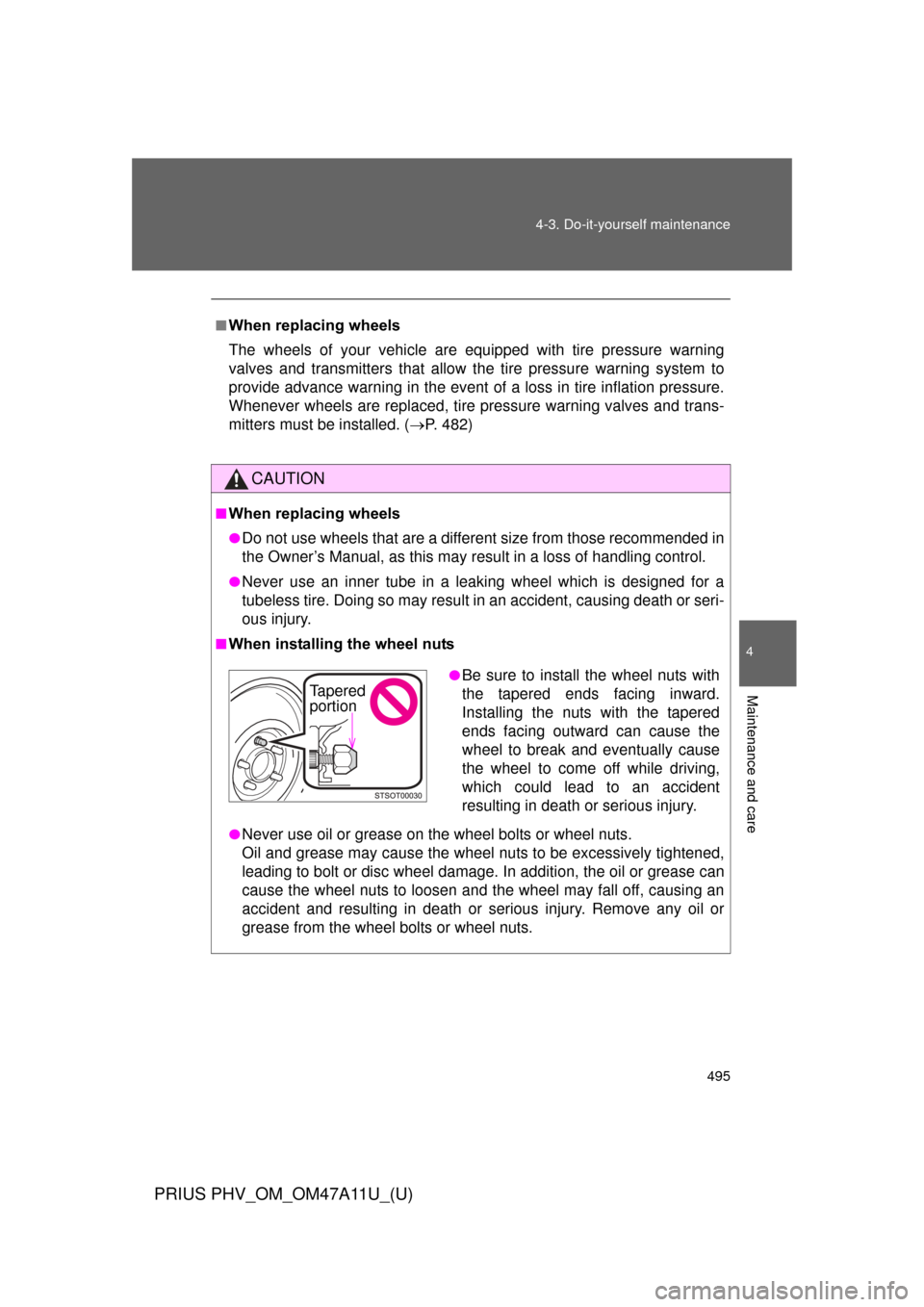Page 488 of 692

488 4-3. Do-it-yourself maintenance
PRIUS PHV_OM_OM47A11U_(U)
CAUTION
■When inspecting or replacing tires
Observe the following precautions to prevent accidents.
Failure to do so may cause damage to parts of the drive train as well as
dangerous handling characteristics, which may lead to an accident
resulting in death or serious injury.
●Do not mix tires of different makes, models or tread patterns.
Also, do not mix tires of remarkably different treadwear.
●Do not use tire sizes other than those recommended by Toyota.
●Do not mix differently constructed ti res (radial, bias-belted or bias-ply
tires).
●Do not mix summer, all season and snow tires.
●Do not use tires that have been used on another vehicle.
Do not use tires if you do not know how they were used previously.
■When initializing the tire pressure warning system
Do not operate the tire pressure wa rning reset switch without first adjust-
ing the tire inflation pr essure to the specified level. Otherwise, the tire
pressure warning light may not come on even if the tire inflation pressure
is low, or it may come on when the tire inflation pressure is actually nor-
mal.
Page 489 of 692

489
4-3. Do-it-yourself maintenance
PRIUS PHV_OM_OM47A11U_(U)
4
Maintenance and care
NOTICE
■Repairing or replacing tires, wheels, tire pressure warning valves,
transmitters and tire valve caps
●When removing or fitting the wheels, tires or the tire pressure warning
valves and transmitters, contact your
Toyota dealer as the tire pres-
sure warning valves and transmitters may be damaged if not handled
correctly.
●When replacing tire valve caps, do not use tire valve caps other than
those specified. The cap may become stuck.
■To avoid damage to the tire pressure warning valves and transmit-
ters
When a tire is repaired with liquid sealants, the tire pressure warning
valve and transmitter may not operate properly. If a liquid sealant is
used, contact your Toyota dealer or other qualified service shop as soon
as possible. Make sure to replace the tire pressure warning valve and
transmitter when replacing the tire. ( P. 482)
■Driving on rough roads
Take particular care when driving on roads with loose surfaces or pot-
holes.
These conditions may cause losses in tire inflation pressure, reducing
the cushioning ability of the tires. In addition, driving on rough roads may
cause damage to the tires themselves, as well as the vehicle’s wheels
and body.
■If tire inflation pressure of each tire becomes low while driving
Do not continue driving, or your tires and/or wheels may be ruined.
Page 495 of 692

495
4-3. Do-it-yourself maintenance
PRIUS PHV_OM_OM47A11U_(U)
4
Maintenance and care
■When replacing wheels
The wheels of your vehicle are equipped with tire pressure warning
valves and transmitters that allow the tire pressure warning system to
provide advance warning in the event of a loss in tire inflation pressure.
Whenever wheels are replaced, tire pressure warning valves and trans-
mitters must be installed. (
P. 482)
CAUTION
■When replacing wheels
●Do not use wheels that are a different size from those recommended in
the Owner’s Manual, as this may resu lt in a loss of handling control.
●Never use an inner tube in a leaking wheel which is designed for a
tubeless tire. Doing so may result in an accident, causing death or seri-
ous injury.
■When installing the wheel nuts
●Never use oil or grease on the wheel bolts or wheel nuts.
Oil and grease may cause the wheel nuts to be excessively tightened,
leading to bolt or disc wheel damage. In addition, the oil or grease can
cause the wheel nuts to loosen and the wheel may fall off, causing an
accident and resulting in death or serious injury. Remove any oil or
grease from the wheel bolts or wheel nuts.
●Be sure to install the wheel nuts with
the tapered ends facing inward.
Installing the nuts with the tapered
ends facing outward can cause the
wheel to break and eventually cause
the wheel to come off while driving,
which could lead to an accident
resulting in death or serious injury.
Tapered
portion
Page 496 of 692
496 4-3. Do-it-yourself maintenance
PRIUS PHV_OM_OM47A11U_(U)
CAUTION
■Use of defective wheels prohibited
Do not use cracked or deformed wheels.
Doing so could cause the tire to leak air during driving, possibly causing
an accident.
NOTICE
■Replacing tire pressure warning valves and transmitters
●Because tire repair or replacement may affect the tire pressure warn-
ing valves and transmitters, make sure to have tires serviced by your
Toyota dealer or other qualified service shop. In addition, make sure to
purchase your tire pressure warning valves and transmitters at your
Toyota dealer.
●Ensure that only genuine Toyota wheels are used on your vehicle.
Tire pressure warning valves and transmitters may not work properly
with non-genuine wheels.
Page 507 of 692
507
4-3. Do-it-yourself maintenance
PRIUS PHV_OM_OM47A11U_(U)
4
Maintenance and care
FUSEAmpereCircuit
15 P FR DOOR 25A Power windows
16 D FR DOOR 25A Power windows
17 DOOR RR 25A Power windows
18 DOOR RL 25A Power windows
19 S/ROOF 30A No circuit
20 ECU-IG NO.1 10A Electric cooling fans, multiplex
communication system, vehicle
proximity notification system
21 ECU-IG NO.2 10A Driver support system, Pre-Colli-
sion System, inside rear view mir-
ror, garage door opener, yaw rate
& G sensor, brake system, naviga-
tion system, tire pressure warning
system, seat belt pretensioners,
audio system, emergency flash-
ers, turn signal lights, windshield
wipers, headlight cleaner
22 GAUGE 10A Headlight leveling system, gauges
and meters
23 A/C 10A Air conditioning system, Remote
Air Conditioning System
24 WASHER 15A Windshield washer
25 RR WIP 20A Rear window wiper and washer
26 WIP 30A Windshield wipers
27 MET 7.5A Gauges and meters
Page 527 of 692
When trouble arises5
527
PRIUS PHV_OM_OM47A11U_(U)
5-1. Essential informationEmergency flashers ......... 528
If your vehicle needs to be towed ........................ 529
If you think something is wrong ............................. 536
5-2. Steps to take in an emergency
If a warning light turns on or a warning buzzer
sounds ........................... 537
If a warning message is displayed........................ 550
If you have a flat tire......... 574
If the hybrid system will not start .................... 596
If you lose your keys ........ 598
If the electronic key does not operate properly....... 599
If the 12-volt battery is discharged ..................... 601
If your vehicle overheats ....................... 607
If the vehicle becomes stuck .............................. 613
If your vehicle has to be stopped in an
emergency ..................... 615
Page 529 of 692

5
When trouble arises
529
5-1. Essential information
PRIUS PHV_OM_OM47A11U_(U)
If your vehicle needs to be towed
Situations when it is not possible to be towed by another vehicle
In the following situations, it is not possible to be towed by another
vehicle using cables or chains, as the front wheels may be locked
due to the parking lock. Contact your Toyota dealer or a commercial
towing service.
● There is a malfunction in the shift control system. ( P. 552)
● There is a malfunction in the immobilizer system. ( P. 183)
● There is a malfunction in the smart key system. ( P. 599)
● The 12-volt battery is discharged. ( P. 601)
Situations needs to contact dealers before towing
The following may indicate a problem with your hybrid transmission.
Contact your Toyota dealer or commercial towing service before tow-
ing.
● The “CHECK HYBRID SYSTEM” warning message appears on
the multi-information display and the vehicle does not move.
● The vehicle makes an abnormal sound.
If towing is necessary, we recommend having your vehicle towed by
your Toyota dealer or commerci al towing service, using a lift-type
truck or flat bed truck.
Use a safety chain system for all to wing, and abide by all state/pro-
vincial and local laws.
Page 536 of 692
536
5-1. Essential information
PRIUS PHV_OM_OM47A11U_(U)
If you think something is wrong
If you notice any of the following symptoms, your vehicle probably
needs adjustment or repair. Contact your Toyota dealer as soon as
possible.
■ Visible symptoms
●Fluid leaks under the vehicle
(Water dripping from the air cond itioning after use is normal.)
● Flat-looking tires or uneven tire wear
● High engine coolant temperatur e warning light flashes or
comes on
■ Audible symptoms
●Changes in exhaust sound
● Excessive tire squeal when cornering
● Strange noises related to the suspension system
● Pinging or other noises related to the hybrid system
■ Operational symptoms
●Engine missing, stumbling or running roughly
● Appreciable loss of power
● Vehicle pulls heavily to one side when braking
● Vehicle pulls heavily to one side when driving on a level road
● Loss of brake effectiveness, s pongy feeling, pedal almost
touches the floor